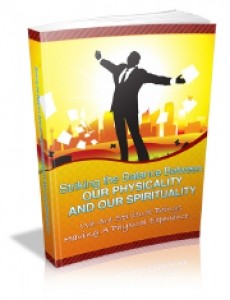 License Type: Master Resell Rights
License Type: Master Resell Rights  File Type: ZIP
File Type: ZIP
 SKU: 3289
SKU: 3289  Shipping: Online Download
Shipping: Online Download
Ebook Sample Content Preview:
Chapter 7: The Power of Prayer
Summary
Prayer is confidence. Prayer is knowledge. Prayer is belief. Prayer is power.
The Power of Prayer “Prayer is when you talk to God. Meditation is when you listen to God.” - Anon
Prayer is defined as the act of addressing a god or spirit with the intention of asking for something or just worshipping and giving praise to the deity. Scientific studies often explore the ability of prayer to heal the sick and injured. But every evening when we get down to pray, it is we who heal ourselves, bringing our mind, body and soul to an intimate get together.
Some African societies still practice Animism, a tradition wherein plants, rocks, waterfalls and even natural phenomena like rain and thunder are believed to embody divinity. Connecting with spirits is still a strong part of animism today. A shaman listens to these spirits and conveys the messages to his people.
In modern times, an individual has to function as his own personal shaman. The Mind prays to the Soul to heal the Body. In these stressful times, the spiritual and physical selves get alienated and sometimes are not even on speaking terms! In the words of William Inge - “ Prayer gives a man the opportunity of getting to know a gentleman he hardly ever meets. I do not mean his maker, but himself.”
Prayer can be externally focused as in Christian, Islamic and Jewish traditions or internal contemplation as in Buddhism. Praying is also used as a faith healing process to prevent or cure illness. While the efficacy of faith healing is looked at with skepticism by the scientific community, both eastern and western science accepts the ability of prayer and meditation to bring about peace in an individual. Whereas community prayer and ritualized religion requires the devotees to use pre-scripted prayers, each individual can also use his own inner dialogue when he meditates alone. Either way can be quite effective to harmonize the body and soul of the truly devout.
Chapter 8: Oriental Methods of Achieving Balance
Summary
The strength that lies in oriental methods to achieve physical and spiritual balance is irrefutable. Here are some methods, explained.
Oriental Methods of Achieving Balance “Teachers open the door, but you must enter by yourself.” - Chinese Proverb
Oriental culture is rich in spiritual philosophy and practice. Numerous martial arts and meditation techniques have explored the relation between the body and mind for ages.
Meditation is a general term for a state of relaxation wherein one moves beyond routine ‘reflex’ thinking into a higher state of consciousness. Practiced across all religions and communities, this discipline has been found to make changes in the circulatory, brain and respiratory processes of the body and also reduce stress significantly.
Qi Gong (or ch'i kung) is a form of Chinese meditation using slow dance like movements and breath control to stimulate the chi (life force) in the body. Studies show that Qigong improves health and makes the body supple and calms the mind. Compared to Oriental martial arts, this practice focuses more on balancing the ‘chi’. Over 200 million people in the world practice variou s forms of qigong today.
Zen Buddhism is a school of Buddhism which believes that human beings have an inherent body of wisdom within themselves (a Buddha nature), which can be gained and perceived through meditation and experiencing life mindfully. This method focuses on self realization through actual experience rather than depending on scriptures and theoretical knowledge.
Acupuncture is a method of sticking needles on certain meridian points on the body to help the Qi (vital energy) to flow smoothly through the body. Chinese philosophy uses the concept of yin-yang, wherein everything in the world has an opposite that moves in harmony with it. Qi is intangible and is the yang of the body - its tangible counterpart is yin, represented by Blood in the body.
Judo (meaning ‘gentle way’) is a Japanese martial art which generally uses the opponent’s force against him. Though developed as a fighting art, its philosophy extends towards improving its practitioner’s physical and spiritual health. Its founder was Jigoro Kano who believed that judo could also maximize efficiency in everyday life outside the martial arena.
Chapter 9: Achieving Balance through Yoga
Summary
Why has the world warmed up to Yoga all of a sudden?
Achieving Balance through Yoga “The meaning of our self is not to be found in its separateness from God or others, but in the ceaseless realization of Yoga, of Union.” - Rabindranath Tagore, Indian Poet
The first image that yoga often brings to our mind is that of complicated postures and exercises. But Yoga means Union. The word yoga comes from the Sanskrit verb ‘yuf, and means "to control"or "to unite".Yoga uses breathing techniques, exercises and meditation to achieve a balance between our physical and spiritual form. Through yoga, one can achieve a total overhaul of the body and spirit and help in maintaining a calm and peaceful state throughout the day.
In traditional Hatha Yoga, one gets into specific asanas or postures and stays in that pose for some minutes. These Yoga asanas tone up all the organs of the body and facilitate a harmonious coordination between all the systems of the body. Thus the muscles, joints and nerves are strengthened and the circulatory, digestive and breathing systems are also stimulated.
Breathing in particular is enhanced by increasing lung capacity. Tight clothes and work stress cause our breathing to be shallow. Yoga teaches how to use the entire breathing system - the lungs, chest, diaphragm and abdomen - to take in more of the life-giving oxygen, thus charging the body and spirit with vital energy.
Proper breathing also balances our frame of mind. Anger makes breathing sharp and shallow. Peace brings about deep and healthy breathing. Fear can make us hold our breath and almost suffocate. The ‘pranayama’ technique involves balancing the ‘prana’ (breath or life-energy) by proper breathing and posture.
The practice of yoga involves less risk of joint or tissue injury, lower calorie consumption, focus on internal awareness and optimized effort as compared to
other forms of exercises and aggressive sports. The physiological, psychological and bio-chemical benefits of yoga are well documented.
You don’t need any kind of expensive equipment or facilities to practice yoga. All you need to bring to the practice is your ‘mind, body and spirit’ along with loads of discipline and a strong desire to achieve a physical-spiritual balance.
- License: Master Resell Rights
- Category:Ebooks
- Tags:2010 Ebooks Master Resale Rights







